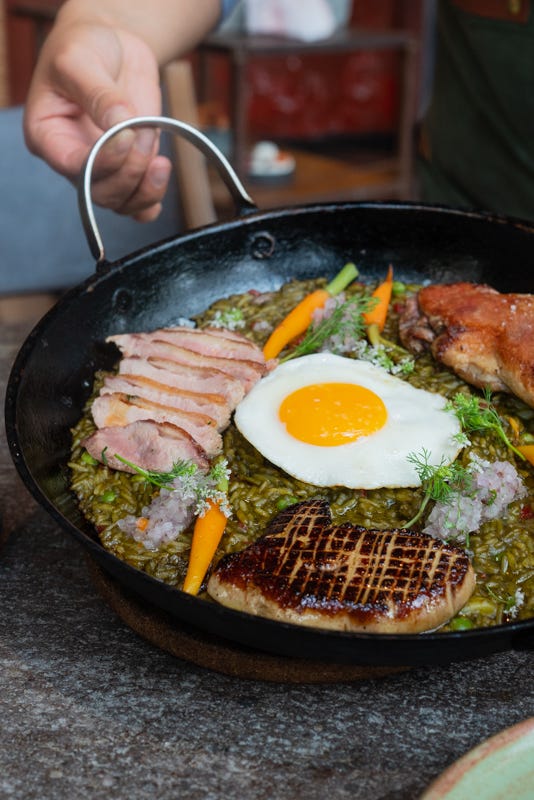Arroz con Pato at Mayta in Lima
Not Your Ordinary Duck Rice
Mayta by Jaime Pesaque, located in Miraflores, Lima1, is a restaurant that’s full of wonderful surprises, big and small. Aside from the name being familiar because it consistently tops the list of Latin America’s best restaurants, we didn’t know much about Mayta when we dropped in. I’m guilty of generally looking at a restaurant’s menu too many times before I visit. As we discovered with Mayta, it’s sometimes better to show up to a meal without any prior knowledge or expectations.
Our first impression of Mayta was how beautiful the space was. I loved the mix of wood, plants, and glass, especially in the Sunday morning light.
Everywhere you look, you could see nice little touches like macerados (pisco infused with fruits and herbs) in Erlenmeyer flasks—a clever, modern touch.
Mayta means “Noble Land” in Aymara, an indigenous language of Peru. Mayta’s vision, according to the website, is the “personal and contemporary expression of the Peruvian cuisine and territory.”
The menu showcases influences from all over Peru. Many restaurants at this level heavily incorporate international influences. However, in contrast, Mayta was decidedly Peruvian2. We ordered two dishes that were inspired by very different regions of Peru. First, we ordered ceviche with ingredients from the Amazon, followed by Arroz con Pato, a dish from Northern Peru.
The Amazonian ceviche featured corvina (sea bass) and banana puree under fried banana chips. The leche de tigre was poured over the ceviche tableside. Then, the waiter added little droplets of charapita3 oil, a nice touch that made this dish really stand out.
I have to say—the team at Mayta has mastered the art of presentation, heightening the overall experience.
Arroz con Pato, literally “Rice with Duck,” is a dish that hails from the town of Chiclayo in Northern Peru. The duck is slow-cooked and then lightly fried while the rice is cooked in a mixture of beer, chicha, and cilantro which gives the rice its signature green color.
Many upscale restaurants in Lima have their own version of Arroz con Pato. However, Mayta’s version, “Sartén de Pato” (pan of duck) on the menu, is unique in how it showcases different parts of the duck. The dish, which is clearly designed for sharing, features a whole duck leg, slices of duck breast, and a generous portion of the liver with a perfectly cooked duck egg on top.
The wide pan maximizes the amount of concolon, the crispy rice that forms at the bottom of the pan after you cook Arroz con Pato. Many Peruvians think that this crispy rice is the best part. With Mayta’s version, there is plenty of concolon so there’s no need to fight over it.
The waiter recommended that we eat a little bit of each element in every bite.


One of the best parts of our experience at Mayta was how it uniquely intertwines taste and presentation.
Our meal was full of little surprises. Looking over at other tables, it was clear that there were many more experiences to be had. I loved seeing how other guests reacted as their dishes were brought out.
Overall, the food and space at Mayta work together to create a beautiful blend of modern and natural elements. I love how the team at Mayta were able to integrate presentation and taste to create such a transcendent dining experience.
By all accounts, Mayta has evolved quite a bit in the last few years and keeps evolving4. The duck rice is just one of the many experiences that you can get at Mayta. For starters, there’s a whole 12-course tasting menu.
I’m always amazed at how the best restaurants in Lima can multi-task so well and how much innovation a single restaurant can pack into one compact menu. I have not seen this keen ability to do so many things well in any other city5 which in my opinion makes Lima one of the most underrated food scenes in the world.
Mayta is located at Av. La Mar 1285, Miraflores, Lima.
Mayta is located mere blocks from several other stellar restaurants including El Mercado, La Mar, and Matria which makes it very difficult to choose.
This is not to say that there are no international touches. Some of the cocktails for example featured Aperol. And there were also a couple of pasta dishes and lomo saltado on the menu but both of those things are essentially Peruvian at this point.
Charapitas are small colorful peppers from the Amazon. They pack quite a kick!
Restaurants in Tokyo, for example, seem to be more focused on doing a single thing very well. As a side note, Lima also has places like anticucherías that focus on doing one thing well.






